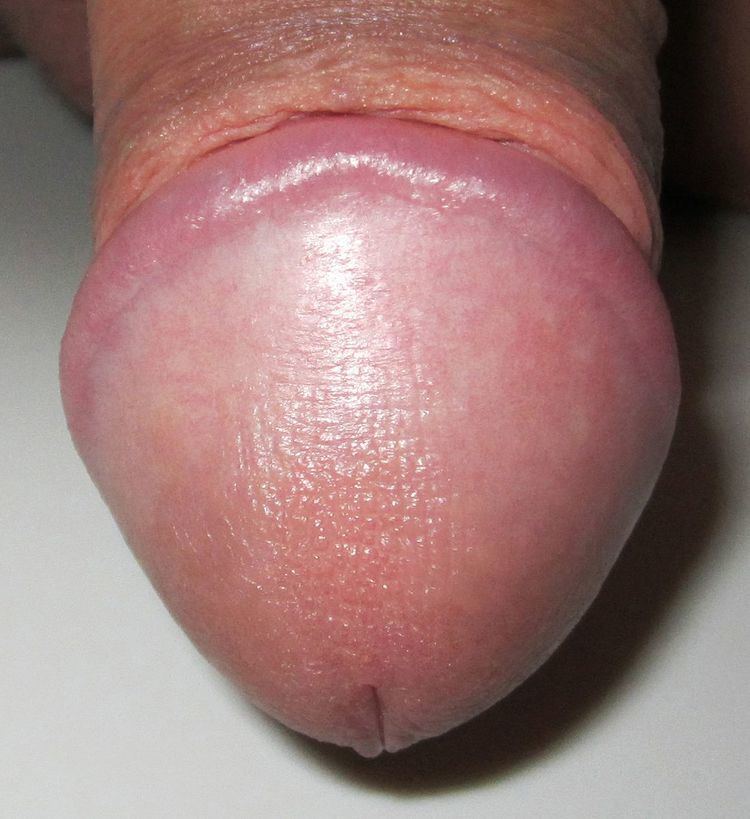Dorlands/Elsevier Glans penis FMA 18247 | Latin Glans penis TA A09.4.01.007 | |
 | ||
The glans penis (or simply glans, /ɡlænz/) is the sensitive bulbous structure at the distal end of the human penis. The glans is anatomically homologous to the clitoral glans of the human female.
Contents
Typically, the glans is completely or partially covered by the foreskin, except in men who have been circumcised. The foreskin can generally be retracted over and past the glans, and may automatically retract during an erection.
The glans is more commonly known as the "head" or the "tip" of the penis. The medical name comes from the Latin words glans ('acorn') and penis ('of the penis') – the Latin genitive of this word has the same form as the nominative.
Medical considerations
The meatus (opening) of the urethra is located at the tip of the glans penis. In circumcised infants, the foreskin no longer protects the meatal area of the glans; consequently, when wearing diapers, there may be greater risk of developing meatitis, meatal ulceration, or meatal stenosis.
The epithelium of the glans penis is mucocutaneous tissue. Birley et al. report that excessive washing with soap may dry the mucous membrane that covers the glans penis and cause non-specific dermatitis.
Inflammation of the glans penis is known as balanitis. It occurs in 3–11% of males, and up to 35% of diabetic males. Edwards reported that it is generally more common in males who have poor hygiene habits or have not been circumcised. It has many causes, including irritation, or infection with a wide variety of pathogens. Careful identification of the cause with the aid of patient history, physical examination, swabs and cultures, and biopsy are essential in order to determine the proper treatment.
Anatomical details
The glans penis is the expanded cap of the corpus spongiosum. It is moulded on the rounded ends of the corpora cavernosa penis, extending farther on their upper than on their lower surfaces. At the summit of the glans is the slit-like vertical external urethral orifice. The circumference of the base of the glans forms a rounded projecting border, the corona glandis, overhanging a deep retroglandular sulcus (the coronal sulcus), behind which is the neck of the penis. The proportional size of the glans penis can vary greatly. On some penises it is much wider in circumference than the shaft, giving the penis a mushroom-like appearance, and on others it is narrower and more akin to a probe in shape.
The foreskin maintains the mucosa in a moist environment. In males who have been circumcised, the glans is permanently exposed and dry. Szabo and Short found that the glans of a circumcised penis does not develop a thicker keratinization layer. Several studies have suggested that the glans is equally sensitive in circumcised and uncircumcised males, while others have reported that it is more sensitive in males who are not circumcised.
Halata & Munger (1986) report that the density of genital corpuscles is greatest in the corona glandis, while Yang & Bradley (1998) report that their study "showed no areas in the glans to be more densely innervated than others."
Halata & Spathe (1997) reported that "the glans penis contains a predominance of free nerve endings, numerous genital end bulbs and rarely Pacinian and Ruffinian corpuscles. Merkel nerve endings and Meissner's corpuscles are not present."
Yang & Bradley argue that "the distinct pattern of innervation of the glans emphasizes the role of the glans as a sensory structure".
In other animals
Male felids are able to urinate backwards by curving the tip of the glans penis backward. In cats, the glans penis is covered with spines, but in dogs, the glans is smooth. Penile spines also occur on the glans of male and female spotted hyenas.
In male dogs, the glans penis consists of two parts called the bulbus glandis and pars longa glandis. The glans of a fossa's penis extends about halfway down the shaft and is spiny except at the tip. In comparison, the glans of felids is short and spiny, while that of viverrids is smooth and long. The shape of the glans varies among different marsupial species. In most marsupials, the glans is divided, but male macropods have an undivided glans penis. The glans penis is also divided into two parts in platypuses and echidnas.
The glans penis of the marsh rice rat is long and robust, averaging 7.3 mm (0.29 in) long and 4.6 mm (0.18 in) broad.
In Thomasomys ucucha the glans penis is rounded, short, and small and is superficially divided into left and right halves by a trough at the top and a ridge at the bottom. Most of the glans is covered with spines, except for an area near the tip.
Winkelmann's mouse can most readily be distinguished from its close relatives by its partially corrugated glans penis.
When erect, the glans of a horse's penis increases by 3 to 4 times. The urethra opens within the urethral fossa, a small pouch at the distal end of the glans. Unlike the human glans, the glans of a horse's penis extends backwards on its shaft.
Males of Racey's pipistrelle bat have a narrow, egg-shaped glans penis.
The glans penis of a male cape ground squirrel is large with a prominent baculum.
